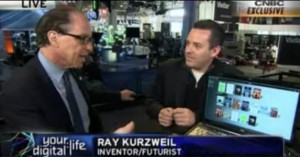Kurzweil Demos Blio at CES (Video)

Share

The book of the future may not seem much like a book at all. Those static pieces of wood pulp bound together with string and glue have served humanity for hundreds of years, but e-readers are starting to offer advantages and changes with which paper cannot compete. No reader demonstrates this more clearly than the Blio platform we've been discussing recently. And who better to help usher in the new age of book-like media than Ray Kurzweil, futurist and inventor. He's been giving some impressive demos of Blio at CES this week. Kurzweil has assured CNBC and CNET that Blio's launch in February will come "with a million free books", and that's on top of the reader itself being available at no cost. (Remember that Blio is a software download, not hardware like a Kindle.) Sounds amazing to me. Check out some great examples of how Blio represents the next step in book evolution in the video from CNET after the break.
Unfortunately the CNET video starts off a little slow (but check out that Singularity University lapel pin Kurzweil is sporting). If you skip to 2:50 in the video, you can see some of the interesting selling points for Blio: preserved book formatting, incorporated animation, and high quality text-to-speech. Synchronizing an audio book performance with the printed pages is done very well at 3:00. The most important demo comes towards the end, however. You can see how e-readers are serving as a transition between print and digital media when Blio embeds video and interactive quizzes into a text book (4:15). As Kuzweil mentions, this type of text enrichment has been around for a while. I've even worked on such projects for textbook publishers. But integrating the ancillary media into the book itself is an amazing and necessary step. The textbook you see on Blio is what I think educational publishers have ultimately been driving towards for years. As I've said before, I have no idea if Blio is going to be a marketable success. That depends a lot on the available titles, how well it works on different hardware (you can see Kurzweil use Blio on an iPhone in this video at 2:17), and general market quirkiness. Still, I have no doubt that Blio's hybridization of published and digital media represents the future of books.
Be Part of the Future
Sign up to receive top stories about groundbreaking technologies and visionary thinkers from SingularityHub.


[screen capture: CNBC]
[video credit: CNET]
Related Articles

This Portable Wind Turbine Is the Size of a Water Bottle and Charges Devices in Under an Hour

Mojo Vision’s New Contact Lens Brings Seamless Augmented Reality a Step Closer
The Weird, the Wacky, the Just Plain Cool: Best of CES 2020
What we’re reading